The NVIDIA GeForce GTX 1080 Preview: A Look at What's to Come
by Ryan Smith on May 17, 2016 9:00 AM ESTGaming Performance, Power, Temperature, & Noise
So with the basics of the architecture and core configuration behind us, let’s dive into some numbers.
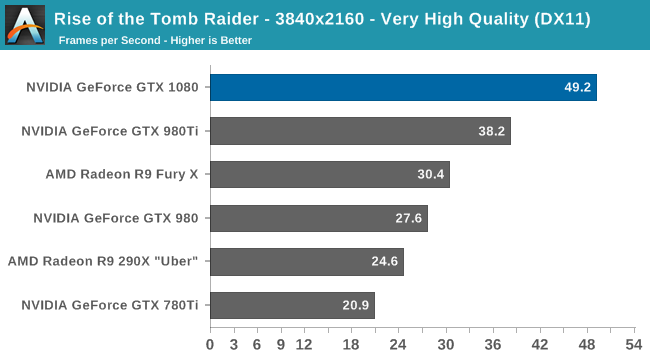

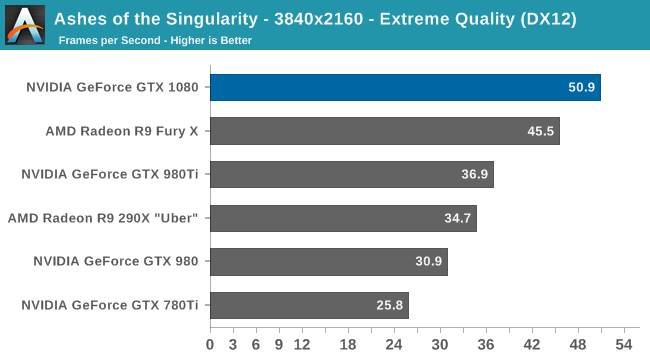

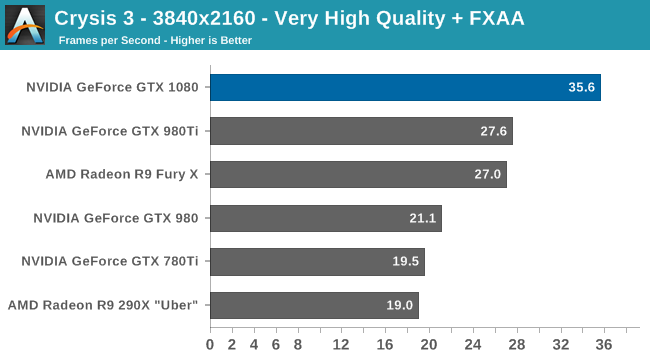
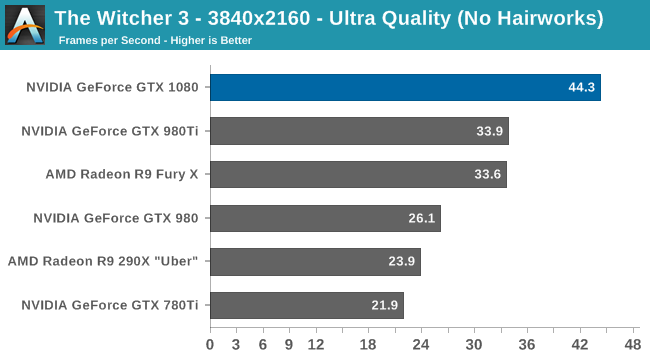
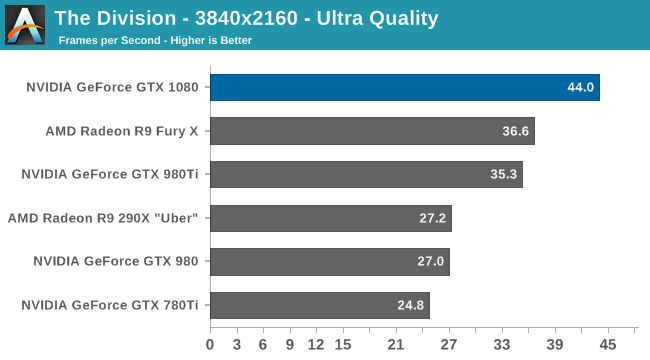
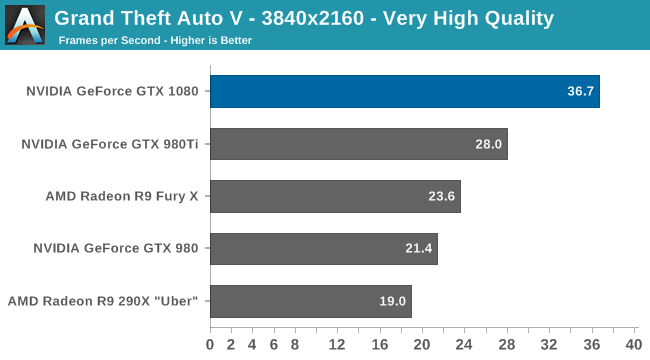
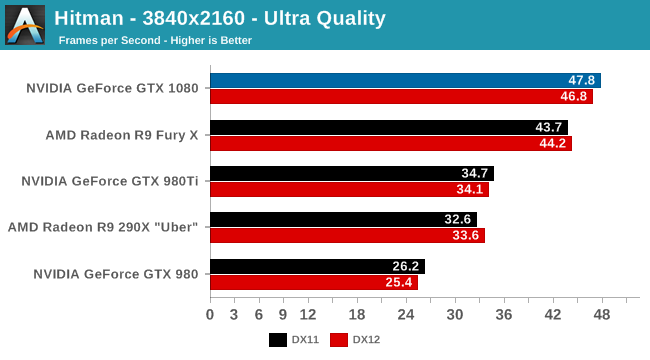
As the first high-end card of this generation to launch, NVIDIA gets to set the pace for the market. At the risk of being redundant the GTX 1080 is now the fastest single-GPU card on the market, and even at 4K it wins at every single gaming benchmark, typically by a good margin. In practice we’re looking at a 31% performance lead over GTX 980 Ti – the card the GTX 1080 essentially replaces – with a similar 32% lead over AMD’s Radeon R9 Fury X. Meanwhile against the slightly older GTX 980, that gap is 70%.
On a generational basis this ends up being very close to the 74% jump in 4K performance going from the GTX 680 to GTX 980. And although the pricing comparison is not especially flattering for NVIDIA here, it should be evident that NVIDIA isn’t just looking to sell GTX 1080 as an upgrade for high-end Kepler cards, but as an upgrade for GTX 980 as well, just 20 months after it launched.
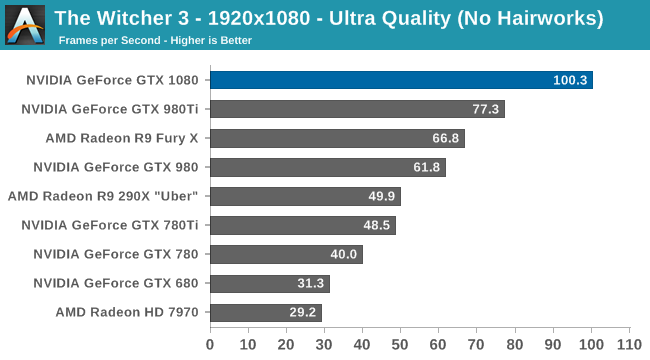
I also wanted to quickly throw in a 1080p chart, both for the interest of comparing the GTX 1080 to the first-generation 28nm cards, and for gamers who are playing on high refresh rate 1080p monitors. Though this will of course vary from game to game, roughly speaking the GTX 1080 should be 3x faster than the GTX 680 or Radeon HD 7970. This is a good reminder of how architectural efficiency has played a greater role in past years, as this is a much larger gain than we saw jumping from 55nm to 40nm or 40nm to 28nm, both of which were much closer to the historical norm of 2x.

Meanwhile when it comes to power, temperature, and noise, NVIDIA continues to execute very well here. Power consumption under Crysis 3 is some 20W higher than GTX 980 or 52W lower than GTX 980 Ti, generally in line with NVIDIA’s own TDP ratings after accounting for the slightly higher CPU power consumption incurred by the card’s higher performance. The end result is that GTX 1080 is a bit more power hungry than GTX 980, but still in the sweet spot NVIDIA has carved out in the gaming market. Broadly speaking, this amounts to a 54% increase in energy efficiency in the case of Crysis 3.
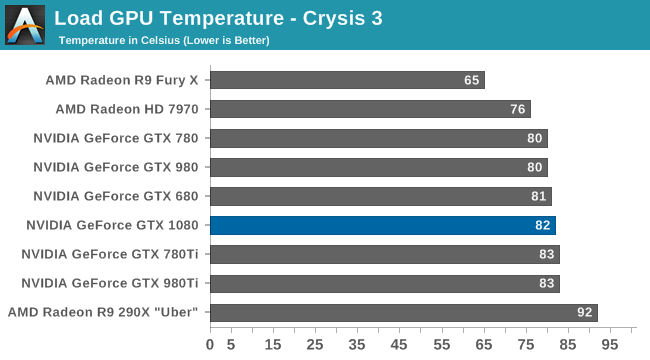
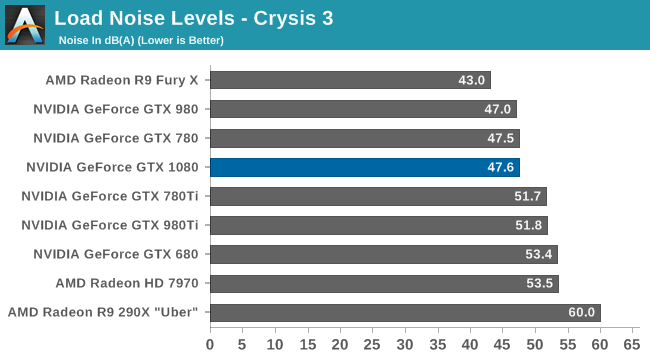
Otherwise from a design perspective the GTX 1080 Founders Edition carries on from NVIDIA’s high-end GTX 700/900 reference design, allowing NVIDIA to once again offer a superior blower-based solution. NVIDIA’s temperature management technology has not changed relative to Maxwell, so like their other cards, the GTX 1080 tops out in the low 80s for load temperature. More significantly, at 47.5 db(A) load noise, the card is on par with the GTX 780 and half a dB off of the GTX 980.
Ultimately NVIDIA has designed the GTX 1080 to be a drop-in replacement for the GTX 980, and this data confirms just that, indicating that GTX 1080’s much higher performance comes with only a slight increase in power consumption and no meaningful change in temperatures or acoustics.


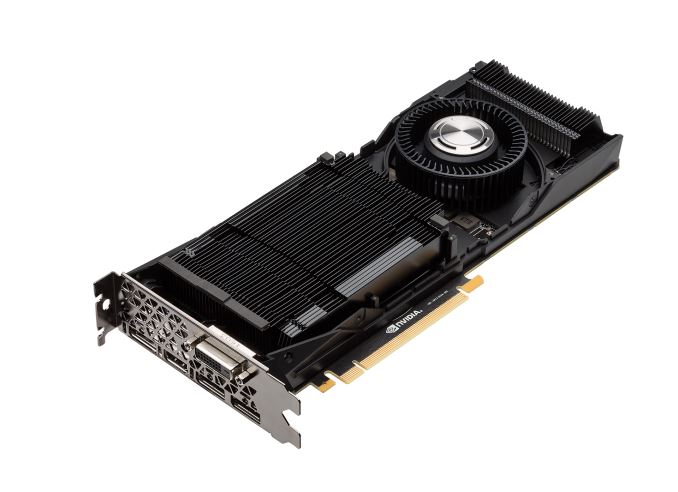








262 Comments
View All Comments
Mlok - Thursday, May 19, 2016 - link
I've seen this alredy in tables in some other articles, so got to ask: since when is memory clock measured in Gbps? Doesnť make any sense to me, one would say clock is measured Hz, while Gigabits per second goes for bandwidth, hm?nick.evanson - Monday, May 23, 2016 - link
The memory clock isn't used for determining processing capabilities, as such, unlike with the GPU core itself, where it is used to determine peak FLOPS, pixel read/writes, etc. In the case of memory, all that matters (on face value) is how much data can be transferred to and from it and this is indicated by the Gbps - the "memory" can shift, say, 7 Gbits per second and because the "bus" is 256 bit wide, the total bandwidth is 1792 Gb/s (or 224 GB/s). So one might ask, why not just quote the bandwidth? This used to be the case, simply because bus width across different vendors and SKUs were remarkably similar compared to the broad variation one sees now.mikable - Thursday, May 19, 2016 - link
When's the MXM version coming out?lashek37 - Friday, May 20, 2016 - link
Has Soon As AMD comes out with their card. Nvidia will unleash the GTX980T.I.😂 Nvidia do this every year lol.Ranger1065 - Monday, May 23, 2016 - link
Anandtech is a good site that I have visited frequently since the early 2000s to quench an insatiable appetite for primarily CPU&GPU reviews. However there are now sites out there, one in particular, that are doing it better than Anandtech and consequently I don't spend so much time here.It is now almost a week since the embargo on GTX1080 reviews was lifted and previews aside, there is still a deafening silence from Anandtech. Yes the apologists will argue Anandtech does a deeper review, give them time and all that but seriously when your review is this late, it begins to look like incompetence. Or perhaps you consider your reviews to be elitist, the holy grail among tech websites and that therefore any delay is acceptable? What pressing projects are the GPU staff working on that could explain this state of affairs?
GET IT TOGETHER ANANDTECH YOU USED TO BE BETTER!
vacavalier - Monday, May 23, 2016 - link
If you own a 980 Ti... No need to get overly excited/worried about upgrading to this particular GPU, unless you just have to have the "latest and "greatest". Initial testing was done vs. the GTX 980? Rather odd and goes back to my initial statement.On the other hand, if running a 970 (or below) and 980 (apparently, according to NV) or 700 series GPU, this presents a very good upgrade-path.
Time will tell what will happen with that MSRP however, once vendors start doing their add-on's; cooling solutions, factory OC's, software bundles, etc...
lakedude - Tuesday, May 24, 2016 - link
I'm shocked every day that goes by that no GTX 1080 review exists yet. The move to 14-16nm has got to be on of the most highly anticipated in recent history an all we have is a preview?? BTW I don't need a tech site to price check the 6700 CPU for me, i can do that myself.Bang4BuckPC Gamer - Wednesday, May 25, 2016 - link
I thought the main purpose of a review was to give a potential customer an idea of what to expect, and some expert analysis, and some honest judgement on a product and whether or not it's worth your money as a consumer. The card releases in two days and if you don't have a review out by then what is the bleeding pointvzortex - Wednesday, May 25, 2016 - link
"later this week" was over last week. No review?tarqsharq - Wednesday, May 25, 2016 - link
I'm kind of expecting it tomorrow, the day before the product gets into people's hands. I know pre-orders already started, but those people were probably going to buy regardless.